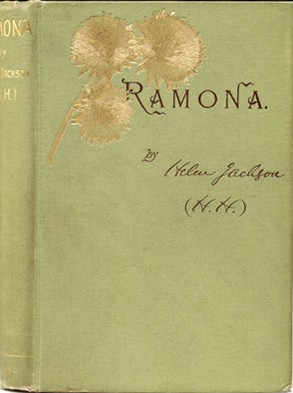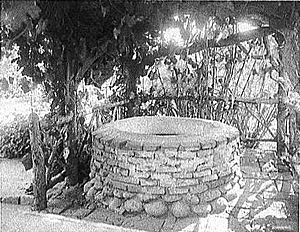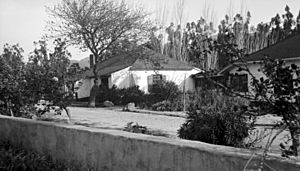Ramona facts for kids

1884 first edition
|
|
| Author | Helen Hunt Jackson |
|---|---|
| Country | United States |
| Language | English |
| Genre | Novel |
| Publisher | Little, Brown |
|
Publication date
|
1884 |
| Media type | Print (Hardback & Paperback) |
| Pages | 335 (2007 ed.) |
| ISBN | 0812973518 (modern) |
| OCLC | 56686628 |
Ramona is a famous American novel written by Helen Hunt Jackson. It was published in 1884. The story takes place in Southern California right after the Mexican–American War.
The book is about a young, mixed-race girl named Ramona. She is part Scottish and part Native American. Ramona faces many challenges and unfair treatment because of her background.
Ramona was first published in parts each week in a newspaper called the Christian Union. It quickly became very popular. The novel has been printed over 300 times. It has also been made into five movies. A play based on the book has been performed every year outdoors since 1923.
The novel had a big impact on Southern California's culture. Its sweet story about Mexican life helped create a special identity for the region. Many tourists visited Southern California to see places from the book. This happened when new railroad lines were opening in the area.
Story of Ramona
The story begins in Southern California after the Mexican–American War. Ramona is a young orphan girl. She is raised by Señora Gonzaga Moreno. Señora Moreno is the sister of Ramona's foster mother, who has passed away. Ramona's parents were married in a church, so she was not born out of wedlock.
Señora Moreno gives Ramona a luxurious life. But she only does this because Ramona's foster mother asked her to before she died. Señora Moreno does not truly love Ramona. This is because Ramona is part Native American. Señora Moreno's love is only for her own son, Felipe Moreno.
Señora Moreno sees herself as Mexican with Spanish family roots. She dislikes the Americans. The Americans have taken over California and cut up her large rancho (ranch).
Señora Moreno waits to shear her sheep, which is a big event. She is waiting for a group of Native Americans from Temecula. She always hires them for this work. The leader of these workers is Alessandro. He is the son of the tribe's chief, Pablo Assís. Alessandro is a good and honest person.
Señora Moreno also waits for Father Salvierderra, a priest from Santa Barbara. He is a holy man respected by everyone. She wants the Native American workers to worship and confess in her chapel before they return home.
Alessandro quickly falls in love with Ramona. He agrees to stay at the rancho. Over time, Ramona also falls in love with Alessandro. Señora Moreno is very angry about this. Even though Ramona is half-Native American, Señora Moreno does not want her to marry a Native American. Ramona realizes Señora Moreno has never loved her. So, Ramona and Alessandro run away together.
The rest of the book tells about the hardships they face. They have a daughter and travel around Southern California. They try to find a place to live. After the war, Alessandro's tribe is forced off their land. This is due to many European-American settlers moving into California.
Ramona and Alessandro suffer greatly. The Americans who buy their land also demand their homes and farm tools. Greedy Americans force them off several places they try to settle. They cannot find a safe community away from the new settlers. They finally move into the San Bernardino Mountains.
Alessandro slowly starts to lose his mind because of the constant unfairness. He loves Ramona very much. He feels bad for taking her away from a more comfortable life. Their first daughter, "Eyes of the Sky," dies. A white doctor would not come to their home to treat her. They have another daughter, also named Ramona. But Alessandro continues to suffer.
One day, Alessandro rides off with an American's horse. The American follows him and shoots him, even though he knew Alessandro was mentally unwell.
Ramona had been away from the Moreno rancho for two years. Felipe Moreno finds Ramona, now a young widow. They return to his mother's estate with Ramona's daughter. Felipe has always loved Ramona and finds her more beautiful than ever. Ramona still loves Alessandro. But since Señora Moreno has died and can no longer stop them, Ramona agrees to marry Felipe. They have several more children together. Ramona, the daughter of Ramona and Alessandro, is their favorite child.
Main characters
- Ramona: A young orphan girl who is part Scottish and part Native American.
- Señora Gonzaga Moreno: The sister of Ramona's foster mother. She raises Ramona but does not truly love her.
- Felipe Moreno: Señora Moreno's only son. He loves Ramona.
- Alessandro Assis: A young Native American sheep shearer who falls in love with Ramona.
- Father Salvierderra: A kind Catholic priest.
Main Ideas
Helen Hunt Jackson wrote Ramona to show the unfair treatment of Native Americans in the United States. She had written a non-fiction book called A Century of Dishonor three years earlier. With Ramona, she wanted to tell the Native American story in a way that would "move people's hearts." She hoped to make people care about their struggles, much like Uncle Tom's Cabin by Harriet Beecher Stowe did for enslaved people. However, her success in this goal was limited.
Jackson wanted Ramona to make readers feel strong emotions. The book's message about politics was clear. But most readers were more touched by its romantic picture of old California. This was when it was ruled by Spain and Mexico. Jackson loved the Spanish missions in California and made them seem very special. The story's made-up world of churchmen, señoritas, and caballeros (Spanish gentlemen) captured readers' imaginations. Her novel showed Americans as bad guys and Native Americans as "noble savages" (meaning good, pure people living close to nature).
Many American settlers had looked down on the Hispanic people of California. They thought the rich Latinos had a lazy culture. These Latinos owned huge amounts of land, lived in a warm climate, and had fertile soil. They also relied heavily on Native American workers. The new settlers often preferred a Protestant work ethic (hard work and saving).
However, not everyone thought this way. American readers in other parts of the country liked Jackson's portrayal of Spanish and Mexican society. They accepted the Californio (people of Spanish descent in California) upper class as shown in the book. This is how the Ramona myth began.
Cultural Impact

The novel became incredibly popular. Because of this, places were named after Ramona. These included schools (Ramona High School in Riverside), streets, and even towns (Ramona, California). A freeway (the San Bernardino Freeway) was first called the Ramona Freeway.
The book helped make Southern California a popular place for tourists. Many people wanted to visit the locations from the story. The book came out at the same time the Southern Pacific Railroad opened its train lines in Southern California. This helped create a big tourism boom.
As a result, many places in Southern California tried to say they were connected to Ramona. Helen Hunt Jackson died without saying exactly where her story was based. Two places claimed to have inspired her: Rancho Camulos, near Piru, and Rancho Guajome in Vista. Jackson had visited both before writing her novel.
Camulos became the most widely accepted "Home of Ramona." This was for several reasons. The Moreno Ranch in the book is described in a way that is similar to Camulos. Important writers like George Wharton James and Charles Fletcher Lummis said it was true. When the Southern Pacific Railroad opened its main line in Ventura County in 1887, it stopped at Camulos. The train trip to Camulos was easy and cheap. Also, the Del Valle family, who owned Camulos, welcomed tourists. They even used the "Home of Ramona" name to sell their oranges and wine.
In contrast, Guajome was not publicly linked to Ramona until 1894. This was when an article in Rural Californian made the claim. However, the house was almost four miles (6 km) from the nearest Santa Fe Railroad station. This made it harder to get there. Also, the Couts family, who owned Guajome, did not want many tourists on their property. This might have been because Jackson and Mrs. Couts had a disagreement.
The Estudillo House in Old Town San Diego called itself "Ramona's Marriage Place." This was because the book briefly mentioned Ramona getting married in San Diego. Even though there was no record of Jackson ever visiting there, it became a popular tourist spot for many years. The Estudillo House was unique because it only marketed itself for Ramona tourism. The caretaker even sold pieces of the house to tourists, which caused it to fall apart faster. In 1907, the new owner, John D. Spreckels, hired an architect to make the house look more like the descriptions in the novel. After the rebuilding finished in 1910, the building reopened as a full Ramona tourist attraction. The Estudillo House's application for National Historic Landmark status was even called "Casa Estudillo/Ramona's Marriage Place."
Other notable Ramona landmarks included "Ramona's Birthplace." This was a small adobe house near Mission San Gabriel Arcángel. There was also the grave of Ramona Lubo on the Ramona Band of Cahuilla Indians reservation. Writer George Wharton James called Lubo the "real Ramona." Her life had some similarities to the fictional Ramona. Sixteen years after Lubo died, local people built a "Ramona monument" at her grave in 1938.
The Ramona Pageant, an outdoor play based on the novel, started in 1923 in Hemet. It has been performed every year since then. It is the largest and longest-running outdoor play in the United States. It is also the official state play of California.
Most historians believe that the Moreno Ranch in the story is a mix of different places. It was not meant to be one single real place. As Carey McWilliams wrote in his book Southern California Country:
- Picture postcards, by the tens of thousands, were published showing "the schools attended by Ramona," "the original of Ramona," "the place where Ramona was married," and various shots of the "Ramona Country." [...] It was not long before the scenic postcards depicting the Ramona Country had come to embrace all of Southern California.
Because the novel was so popular, people often mixed up facts and fiction. California historian Walton Bean wrote:
- These legends became so ingrained in the culture of Southern California that they were often mistaken for realities. In later years many who visited "Ramona's birthplace" in San Diego or the annual "Ramona Pageant" at Hemet (eighty miles north of San Diego) were surprised and disappointed if they chanced to learn that Ramona was a (fictional) novel rather than a biography.
The novel helped create the unique culture of Southern California and the entire Southwest. The architecture of the missions had recently become well-known. Local projects to restore them were just starting. Train lines to Southern California were just opening. All these things, combined with the emotions stirred by the novel, made the region famous across the country. The Mission Revival Style architecture became popular from about 1890 to 1915. Many examples of this style can still be seen throughout California and other Southwest areas.
Adaptations
Ramona has been made into other forms of media several times:
- Ramona (1910 film): A 17-minute silent film directed by D. W. Griffith. It starred Mary Pickford.
- Ramona (1916 film): Directed by Donald Crisp.
- Ramona (1928 film): Directed by Edwin Carewe. It featured Dolores del Río and Warner Baxter.
- Ramona (1936 film): Directed by Henry King. It starred Loretta Young and Don Ameche.
- Ramona (1946 film): Directed by Víctor Urruchúa.
- Screen Guild Theater: A 1945 radio broadcast.
- Ramona (2000 TV series): A Mexican TV show (telenovela).
- The Ramona Pageant: An annual outdoor play performed since 1923 in Hemet, California. It is the biggest and longest-running outdoor play in the United States. It is also the official state play of California.
See also
 In Spanish: Ramona (novela) para niños
In Spanish: Ramona (novela) para niños



